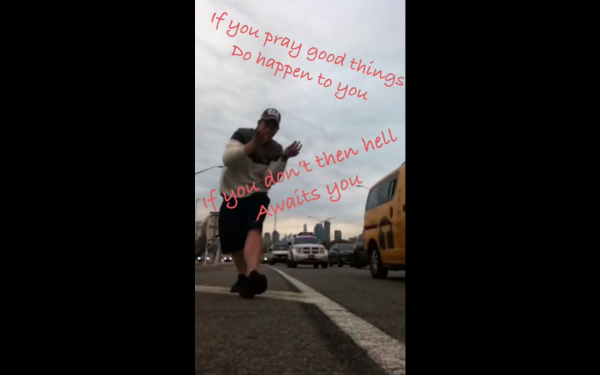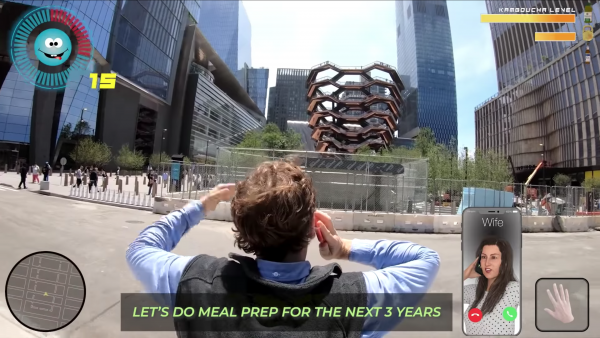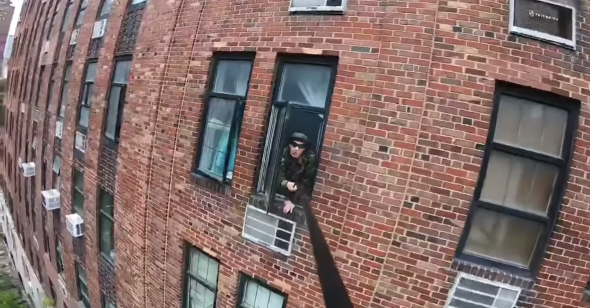Lambs to the Slaughter:
The Weird and the Normal of Conner O’Malley
By Chloe Lizotte
The camera does midair donuts on what must be a three-meter selfie stick: it’s suspended out the window of a brick apartment building, several floors above ground, and the cameraman rattles it into seismic tremors. He reels it inside, and we’re face-to-face with a man wearing camouflage fatigues and neon wraparound sunglasses. “This is a direct message to Governor Comb,” he snarls, as smoke billows behind him in a disaster area of bedroom. “You’ve gotta ooooopen up the state of New York.”
The camera is out the window again, a couple of floors below—“I’m tired of being inside, dude. We have had enough. We have had ENOUGH”—he yanks it back and it crashes down onto his radiator. New York needs to reopen, immediately, for BIRDFEST 2020, a festival he’s been planning for the past two years by booking extra-contemporary headliners—Avenged Sevenfold, Soulja Boy, Clay Aiken and Ruben Studdard—and capturing “thousands” of New York’s most “out-of-sane” birds, like toucans and “Soprano Bird.” He death-growls the middle-school diary refrain of Metallica’s “Frantic” over its thunking, disengaged snare drum: “My lifestyle / Determines my deathstyle.”
For comedian Conner O’Malley, there are two identities: “weird guy” and “normal guy.” Those familiar with O’Malley’s larynx-shredding characters might first align him with “weird guy,” an incel whose tenuous grip on reality comes from 4chan, Halo, and The Dark Knight: aside from planning BIRDFEST 2020, one of his alter egos defended a Wisconsin outlet mall from QAnon-level credible terrorist threats by doing pushups in the parking lot and asking passersby if they had seen “any ISIS.” But this is one stop on the road to “normal guy,” a psychopathic product of extreme wealth and patriotism, like Iron Man, or Amazon reboot-era Jack Ryan—which amounts to a fantasy of a phoenix rising from weird-guy ashes.
In his 2019 YouTube short Howard Schultz tapes (4K FULL MOVIE 2019 FREE), O’Malley—playing an unhinged 17-year-old devotee of Starbucks CEO Howard Schultz’s presidential bid—becomes a “normal guy” after he is brainwashed by Schultz’s “mobile response unit” in hazmat suits and Starbucks aprons. Released into the wilds of the Queens Center mall with dried blood on his temple, O’Malley explains to baffled patrons that serum injections have “made [him] normal”; here, normalcy means perusing The Disney Store and VR booths, doing jumping jacks in the galleria, trying to join the military, and declaring himself “bailiff of the food court.” This is a distinctly contemporary American hellscape, but if Charlie Chaplin and Jacques Tati were socially aloof within environments of cold modernity, O’Malley’s outcasts can barely communicate as they navigate a world corroded by mediation.
O’Malley’s writing and acting credits seem suited to an alt-comedy series order: he co-writes and co-stars in Adult Swim’s Joe Pera Talks With You, brought some memorable frenzy to a couple of sketches on I Think You Should Leave with Tim Robinson, and both wrote and interpretive danced for Late Night with Seth Meyers from 2014 to 2016. But the character pieces he’s churned out since 2016 make a different kind of sense on user-dominated platforms like YouTube, Twitter, Periscope, and the now defunct Vine.
There’s an outsider art quality to some of his work; questions multiply about backstory as O’Malley yells obscenities into a portrait-mode frame while digging up raw meat next to the highway in christians_in_action.JPG (2018). Many pieces, presumably edited by his characters—although the rapid-fire cuts and skillfully crude Photoshops suggest more specialized expertise—emulate the arcs and conventions of personality-driven reality TV. Others, like the Schultz tapes, move through disorienting phases: first a found-footage doc, then a body-snatcher horror movie, and finally, as a Windows Movie Maker title card reveals, a covert PSA “payed [sic] for by the committee to elect Howard Schultz.” In that DIY sense, O’Malley’s closest comedy links might be Tim Heidecker and Eric Wareheim’s canny recreations of amateur public access television, where awkward rhythms speak volumes about their characters. As O’Malley’s creations slot themselves into their favorite stories—from the American Dream to The Matrix—everything is aesthetically destabilizing; they explode in profanity-laced tirades as Go-Pros blur their surroundings beyond recognition.
That abrasive pitch matches the whirlwind in his characters’ heads, all logic-defying free associations. It’s fair to say that O’Malley’s audience is self-selecting: in the case of the Schultz tapes, O’Malley’s commitment to the bit earned a YouTube community content warning, although it speaks to the video that it’s hard to say if this is because of the Starbucks employee torture sequence, or because he appears covered in blood and shirtless, wearing an EKG and bright orange contact lenses, bellowing “I AM NORMAL” in the middle of a garbage dump.

+++++
O’Malley started making videos on Vine in 2013. After moving to New York from Chicago, where he performed sketch and improv at the Annoyance Theatre, he was struck by how unselfconscious businessmen on the street seemed wearing ridiculous, grossly expensive suits. His first few uploads, shot from his bike, scope out their Maseratis and Porsches while intoning “hell yeah, pimp!” with the excitement of a brain-dead thirteen-year-old. He slips into a cult of one as he knights the drivers “angel pimps” and begs either for food or death by their hand, or at least a trip to Dave & Buster’s. Then O’Malley tips more overtly into madness: roaring that the Doritos company is plotting mass extermination, shrieking that boots on convertibles are “trying to trap the kings and the job creators,” and misidentifying helicopters as demons. It’s man-on-the-street performance art, but O’Malley’s first-person camera adds a spectral mystique: instead of a body, his last-days energy lurches around New York in thrall to vulgar excess, tilting upwards as if awakening for doomsday—and hashtagging it with garbled pleas to see Grudge Match and sustain a cultural death rattle.
The swerves into alt-right ideology that freak out O’Malley’s targets—he’ll move from complimenting a tacky Harley Davidson to “white people are number one, am I right?”—are part of an associative web in O’Malley’s character work. With his comedy partner and production company co-owner Joe Pera, O’Malley made a few 2016 shorts and a 2017 sketch pilot as Mark Seevers, the host of the InfoWars-style TruthHunters.com. When it comes to his characters’ frequently repulsive politics, O’Malley doesn’t use irony as a distancing tool: Mark, clad in voluminous jeans that seem proportioned for Lego figures, interviews Trump supporters on the ground at RNC events, but he always veers away from MAGA talking points and into disarming personal details (his father kept him in a cage for a year; he has never had his photo taken in a social setting). And when his characters aren’t clinging to hope that a Donald Trump presidency might bring them prosperity in the form of vats of relish, as Mark does, they often end up dead after a lifetime of joblessness and familial neglect. Even though O’Malley trusts viewers to parse the ridiculousness of his characters’ odd syntax and 13 Hours–informed xenophobia, his aggression induces the same kind of seen-too-much claustrophobia as a disenfranchised Twitter feed.
O’Malley’s satire isn’t trying to diagnose “Trump’s America,” but rather channel the id of the mainstream contexts surrounding him. To create ad breaks for O’Malley’s warped late-night parody The 2Nite $how $tarring Johnny Carson (2017), editor Andrew Peyton stitched together archival TV clips into a continuum of pacifying and other-ing: casual homophobia in In Living Color, commercials for sleep aids or guns or Bozo the clown, audio snippets of porn, and a smorgasbord of network tags for Gulf War news coverage. And O’Malley’s fervor bears some kinship with Charlie Sheen’s ill-fated 2010 ABC News interview to prove that he’d kicked his drug use: the conceit itself is a PR construction, while Sheen’s erratic claims to “tiger blood” were inevitably memed.
As O’Malley spins dark comedy from cries for help cloaked in the spectacle of “winning,” he has a knack for invoking actors with upsetting or bizarre Wikipedia Personal Life sections, ranging from the obvious, like Gary Busey, to the forgettable, like Jerry O’Connell. Some of O’Malley’s wanderers direct their reactionary rage toward this trash heap: in Miller Time (2017), he plays a struggling, Pizzagate-curious Dennis Miller impersonator in Times Square, whose checkered history includes a physical altercation at Six Flags. “I wish I could do something else with my life, but I can’t, I’m just drawn to it,” he admits at a personal nadir. “I kind of don’t even like Dennis Miller.” All the same, Tears for Fears’ “Everybody Wants to Rule the World” plays during an inspirational outro; True Life or “IN MEMORIAM” title cards sometimes give O’Malley’s crusades a cursed, ironic nobility (often edited by Jack Bensinger, who’s spoofed cheaply inspiring TV in his own work).
Although a pop monoculture that might recognize Miller has gone extinct—for better or for worse—it’s also true that a modern counterculture is too diffuse to be unifying. O’Malley’s vulgarity likely couldn’t strike a collective nerve in the way that John Waters’s work riled up the Catholic church; today’s culture wars depend on close analysis of corporate IP like Star Wars. So, seeking a calling, O’Malley’s lost souls offer their body and blood to what’s left: brands. In livestreams that channel the energy of his Vine persona, O’Malley barrels through highway traffic and whips around a selfie stick to “pop off” for entities like Verizon, Chase Bank, or both. With brand names airbrushed on his clothes or Sharpie’d on his face, he pledges his allegiance as if possessed by an algorithm. In one Periscope stream, he excitedly chants “WE ARE ALL COMPLACENT” while getting “lit” for Raytheon missiles.
During the real-time peril of these livestreams, O’Malley always seems out-of-bounds: not just in danger of getting hit by a car, but displaced from the realm of human behavior, which is intensified by backdrops like concrete overpasses near LAX (and O’Malley insists that the liminal mall of the airport features the hottest restaurants and dopest buildings in L.A.). His mania is usually couched as “spreading awareness,” as it is when he runs after school buses to promote the #MinionSquad, a (one-man) group of supporters of the animated characters, almost algorithmic-seeming sensory catnip for children. As a neon-gear-clad O’Malley pitches the squad in MINION SQUAD MILWAUKEE EDITION (2018), it’s like he’s either trying to foster a personal connection to the idea that corporations are people, or dissociate into a vapid, cartoon consciousness to cope with an economy in which he has no value. As he’s hyping up Raytheon, O’Malley mentions that he hasn’t been compensated by Whole Foods for his real job: circulating and asking shoppers if they’re having a good time (this could also be because he’s “not allowed to talk to women,” if you accept at face-value that the job is real).

+++++
In O’Malley and animator Cole Kush’s Hudson Yards Video Game (2020), this perspective on economic alienation begins to take on Call of Duty overtones. With the camera affixed to his back like a first-person shooter POV, O’Malley bounds around the Manhattan luxury development/mall chirping “HI!” to score points for his health meter. Interaction moves from transaction to dada in cutscene chats with tech bros (Bensinger and Mike DiCenzo), flailing like poorly rendered PlayStation characters, about gifting DVDs of Netflix drivel to their wives; “Michelob Ultra” suffices as a response.
The simulacrum dissolves into the abyss once O’Malley “unlocks allyship”: Kush animates a level-up sequence with the grotesque bodily proportions familiar from his and Jay Weingarten’s pilot Dayworld. Tool’s melodramatic prog jam “Schism” blares, its bizarre video displaced to an exploding brain, as an animated O’Malley writhes and walks on all fours amid dissolving chakras, Apple payments, and brain scans. A series of fake, typo-ridden “inspirational quotes” endorse violence or self-obliteration (“No excuses, you must kill if you want to own 15 privet jets”—Jim Rohn). O’Malley evolves into a Hulk-like being and body-slams his past self; the visual hilariously evokes the anti-humanism of efficiency—this is a world where meal prep passes for cooking and the rusty honeycomb of the Hudson Yards Vessel passes for architecture. But these ideals, taken to extremes, feed his isolating hallucinations of self-actualization. Once O’Malley similarly “merges with the cyber” in the Jordan Peterson-inflected Leather Metropolis dir Michael Bay (2003) (2020), he explains, “My cheat code is confidence…look yourself in the mirror and say, ‘I am the number one fucker.’”
During COVID quarantine, O’Malley has ratcheted up his usual themes in a handful of new videos: in addition to launching BIRDFEST, he smoked 500 cigarettes to spread the gospel of 5G, and buried himself alive to seek guidance from the supernatural financial realm. He’s also refashioned his talk-show project into a farce of normalcy. As primetime and late-night talk loses its cultural primacy, its artificiality only seems more useless; comedians like Jena Friedman and Eric Andre have skewered the hypocrisy of offering certain guests a friendly platform, or the absurdity of its constructed interactions. O’Malley’s talk shows never have guests, but he does sustain a one-sided feud with middlebrow hero Greg Kinnear for the honor of hosting shows from the river (2018) and the lake (2019). It’s a glamorous job: while windmilling a selfie stick underwater, O’Malley treads and gargles polluted water, and barks threats to Kinnear during a “topical” monologue (breaking: “the Fox ‘n’ Friends are poly!”).
Bike Talk Show (only talk show on a bike) (2020) deepens into psychodrama: editor Danny Scharar weaves together footage from O’Malley’s weekly YouTube livestreams in March and April, in which he would monologue while biking through Manhattan’s empty Theater District with a Go-Pro. That surreality—billboards and neon logos hovering above O’Malley as he claims talk show hosts as “first responders,” or chews up scotch tape with mouthwash to “create new money”—is a funhouse mirror of the content economy: a deluge of garbage in a wasteland of a crisis, where teeth-gnashed tweet formulas like “I feel like I’ve been socially distanced for the past 50 years!” convey nothing to nobody.
The tenor of Bike Talk Show changes when O’Malley is beaten to the ground by a man who claims to be Kinnear’s body double; the moment is rattling in its sudden, sticky gore. O’Malley switches on a DV camcorder in a derelict bathroom, and in grainy passages of vlog-style found-footage, he washes the dried blood from his face, loads a Joker makeup tutorial on his phone, and gets to work. Gritty reboots might condition us to accept the psychology of "Going Joker" without any irony, but O’Malley, singing Lady Gaga and donning a Marge Simpson wig, obliterates that self-seriousness. Even seamless absorption is a joke; it’s a sight gag to spy a bottle of gentrifier-friendly Mrs. Meyer’s soap on his sink.

++++
O’Malley’s comedy asks: in a world that’s unsustainable for all but the über-wealthy—where cartoons and commercials teach us to communicate, and actors from The Office also play Tom Clancy characters—can anything have real impact? When Joker Guy is reborn with a “rock ‘n’ roll attitude” in a theme sequence that trades the inanity of Katy Perry for the cartoonish cool of Audioslave, all he can do is rework Hamilton lyrics into a halting screed about self-isolation. And after a guest appearance on the late-night show De Niro’s Heroes—in which O’Malley green screens himself into the talk show sequence from Joker, but reworks it into his climactic unmasking of a Kinnear-centric global conspiracy—the idea of a blockbuster comic book property hand-wringing about what you “can” and “can’t” joke about, antihero or not, seems inconsequential.
It’s striking how much O’Malley’s videos hold up to repeat viewings, even when the twists are familiar. There’s an oddly cleansing honesty to his delivery, a frenetic search for meaning in a world swallowed up by abstraction.The opening of Adam Curtis’s HyperNormalisation, whose associative montages aren’t dissimilar from some of O’Malley’s editing choices, comes to mind: “Extraordinary events keep happening that undermine the stability of our world… Over the past 40 years, politicians, financiers, and technological utopians—rather than face up to the real complexities of the world—retreated. Instead, they constructed a simpler version of the world in order to hang onto the power. As this fake world grew, all of us went along with it because the simplicity was reassuring.”
Curtis catches “radicals, artists, and musicians” in his crosshairs as casualties of this make-believe universe, too. But O’Malley doesn’t pretend to regain control through his characters’ bouts of confusion and conviction: call it a “lifestyle” and a “deathstyle.” His independent projects also mock the idea that commercial entertainment could stand in for political action or fill a spiritual void. Per his recent tweet: “I have been hired by the Vatican bank and Toyota to write and direct a catholic reboot of Highlander franchise for the catholic streaming service CBS all access that will serve as the third testament of the Bible.”
After killing De Niro (an unmasked Kinnear) on-air, Joker Guy is hailed as a hero in a montage that puts Travis Bickle’s final fêting to shame: he’s Photoshopped into the Disney upfronts, Carpool Karaoke, and Comedians in Cars Getting Coffee with Andrew Cuomo. This overlapping of the entertainment apparatus with centrist liberal politics—“I’m like a human Livestrong bracelet,” he says in voiceover while receiving a medal from Joe Biden—is the dynamic that powers O’Malley’s most recent livestream, BIKE TALK SHOW LIVE IN PORTLAND (ON FOOT) (2020). O’Malley hosts his show from the middle of a July 19 police brutality protest, and as his eyes start watering from tear gas, he insists the “Pepperoni Gas” feels great; back in New York, he praised Bill de Blasio for introducing the 8:00 p.m. curfew as a “bedtime” and empowering the NYPD to protect Midtown salad cafés. While moving through the crowd, he monologues about his dreams of launching Drumpfworld.com and a female reboot of Jack Ryan, but he also carefully foregrounds what’s unfolding around him, tear gas billowing as the federal officers advance toward protesters. As the stream progresses, he breaks kayfabe for longer stretches, chanting with protesters until the police set off more canisters with earsplitting bangs.
With O’Malley’s yell that it’s “orange covfefe smoke,” his real-life invocation of tepid #Resistance tweets emphasizes their complacent distance from actual praxis. And in this context, the real focus is not O’Malley’s noise, but the way the world absorbs it into its own.
